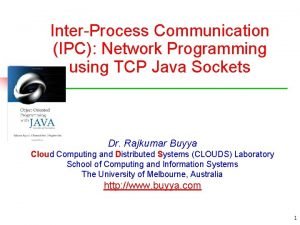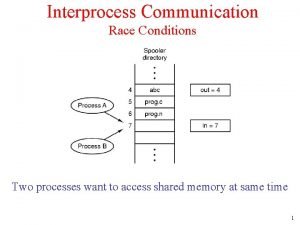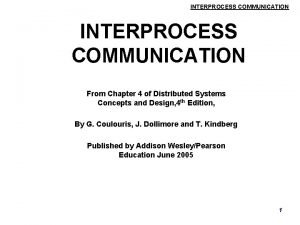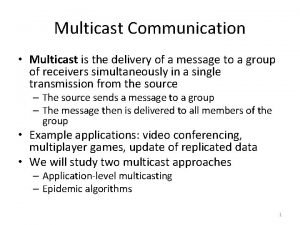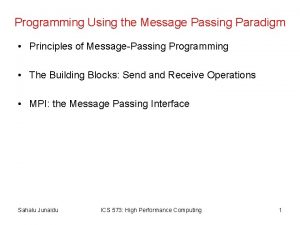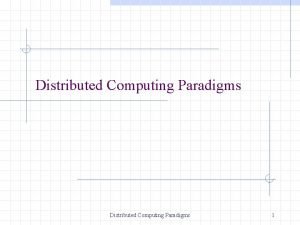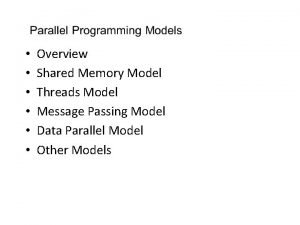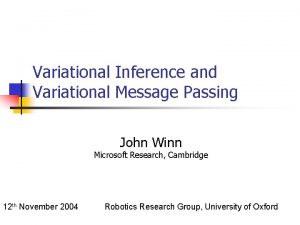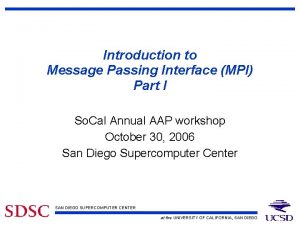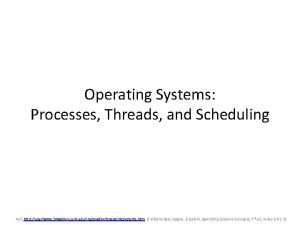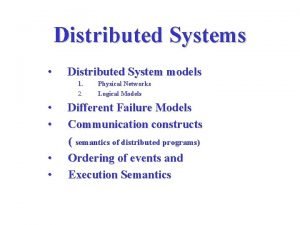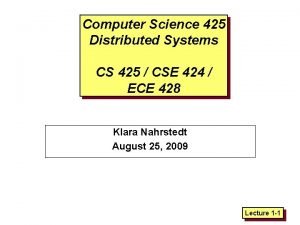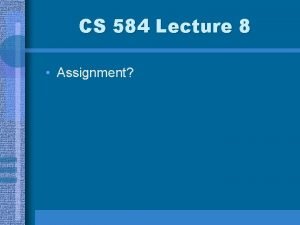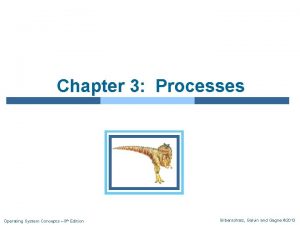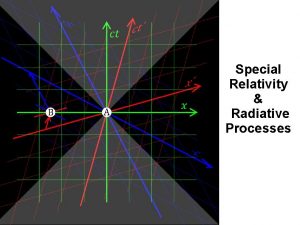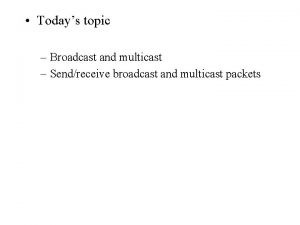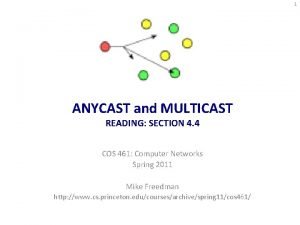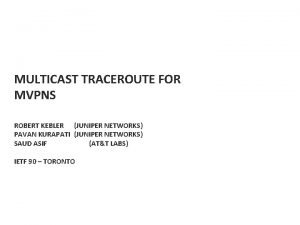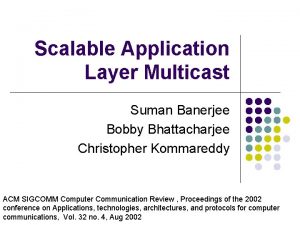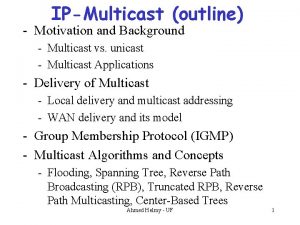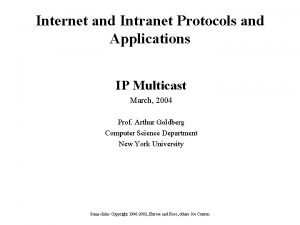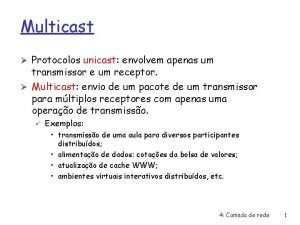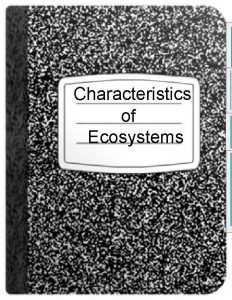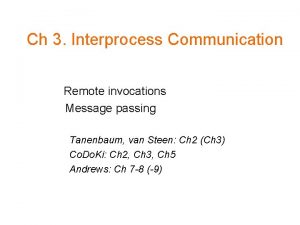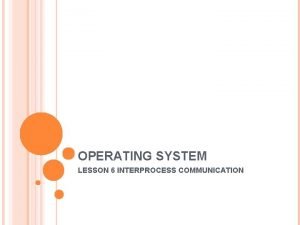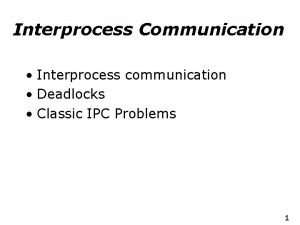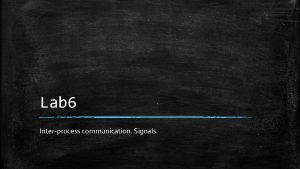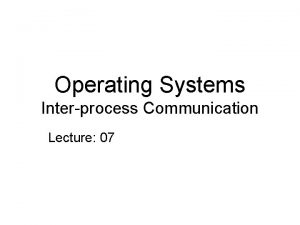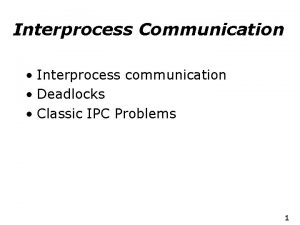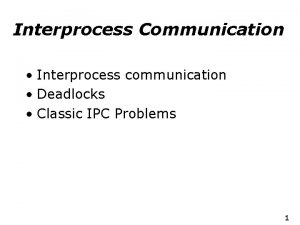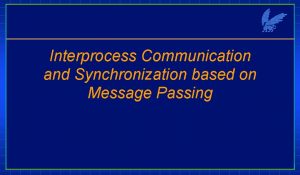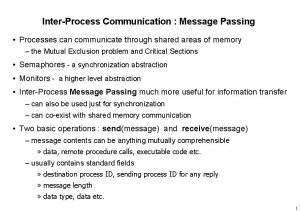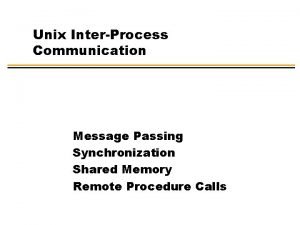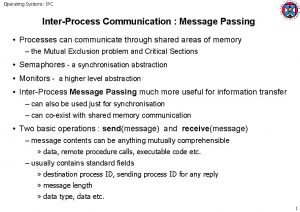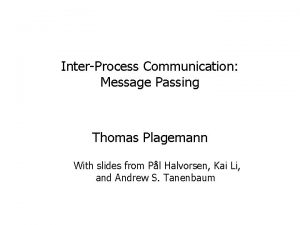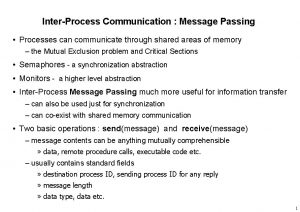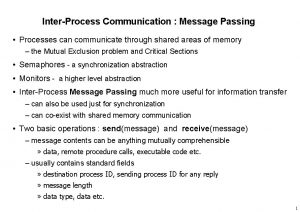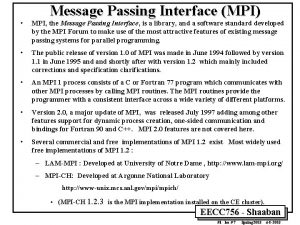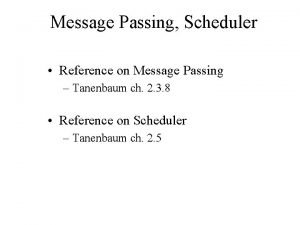Interprocess Communication Remote invocations Message passing Streams Multicast

















































- Slides: 49

Interprocess Communication Remote invocations Message passing Streams Multicast Tanenbaum, van Steen: Ch 2 (Ch 3) Co. Do. Ki: Ch 2, Ch 3, Ch 5 Andrews: Ch 7 -8 (-9)

Middleware Protocols General purpose services -Naming, “browsing” -Security -Atomicity -Higher-level communication -RPC, RMI -Message passing -Reliable multicast An adapted reference model for networked communication.

Remote Procedure Calls • Form: see Andrews, p. 363 • Example: Andrews, Fig. 8. 2 • Notice: – “passive” routines – available for remote clients – executed by a local worker process, which is invoked by the local infrastructure • Implementation: see Tv. St, Ch. 2. 2

RPC goals • to achieve access transparent procedure call • cannot fully imitate – naming, failures, performance – global variables, context dependent variables, pointers – Call-by-reference vs. call-by-value • Call semantics – Maybe, at-least-once, at-most-once – Exception delivery • Can be enhanced with other properties – – Asyncronous RPC Multicast, broadcast Location transparency, migration transparency, … Concurrent processing

RPC: a Schematic View System A System B X, Y, Y Z FNCT(a, b) c: ={comp} return c. Thread P … Y=FNCT(X, Y) … a: =X; b: =Y; RPC package

Implementation of RPC (1) • RPC components (Bacon, Fig. 15. 7) : – RPC Service (two stubs) • interpretation of the service interface • packing of parameters for transportation – Transportation service: node to node • responsible for message passing • part of the operating system • Name service: look up, binding – name of procedure, interface definition

Passing Value Parameters Steps involved in doing remote computation through RPC

Writing a Client and a Server The steps in writing a client and a server in DCE RPC.

Binding a Client to a Server Client-to-server binding in DCE.

Implementation of RPC (2) Server: who will execute the procedure? • One server process – infinite loop, waiting in “receive” – call arrives : the process starts to execute – one call at a time, no mutual exclusion problems • A process is created to execute the procedure – parallelism possible – overhead – mutual exclusion problems to be solved • One process, a set of thread skeletons: – one thread allocated for each call

Distributed Objects • • • Remote Method Invocation ~ RPC; see Fig. 2 -16. A distributed interface – binding: download the interface to the client => proxy – “server stub” ~ skeleton The object – resides on a single machine (possible distribution: hidden) – if needed: “object look” through an adapter (see: Fig. 3 -8) – an object may be persistent or transient Object references: – typically: system-wide – binding: implicit or explicit resolving of an object reference Binding and invocation: see Fig. 2 -17 Examples: CORBA, DCOM (Ch. 9. 1, 9. 2)

Distributed Objects Fig. 2 -16. Common organization of a remote object with client-side proxy.

Object Adapter Fig. 3 -8. Organization of an object server supporting different activation policies.

Binding a Client to an Object Distr_object* obj_ref; obj_ref = …; obj_ref-> do_something(); //Declare a systemwide object reference // Initialize the reference to a distributed object // Implicitly bind and invoke a method (a) Distr_object obj. Pref; Local_object* obj_ptr; obj_ref = …; obj_ptr = bind(obj_ref); obj_ptr -> do_something(); //Declare a systemwide object reference //Declare a pointer to local objects //Initialize the reference to a distributed object //Explicitly bind and obtain a pointer to … // … the local proxy //Invoke a method on the local proxy (b) Fig. 2 -17. • (a) Example with implicit binding using only global references • (b) Example with explicit binding using global and local references

Parameter Passing Fig. 2 -18. The situation when passing an object by reference or by value. Copying must not be hidden! Why?

Design Issues • Language independent interface definition • Exception handling • Delivery guarantees RPC / RMI semantics – maybe – at-least-once – at-most-once • Transparency (algorithmic vs behavioral)

RPC: Types of failures • • client unable to locate server request message lost – • • retransmit a fixed number of times before throwing an exception server crashes after receiving a request or reply message lost (cannot be told apart!) – client resubmits request – server choises • re-execute procedure: service should be idempotent • filter duplicates: server should hold on to results until acknowledged • client crashes after sending a request – orphan detection: reincarnations, expirations • Reporting failures breaks transparency

Fault tolerance measures Retransmit Duplicate Re-execute/ retransmit request filtering no not appl invocation semantics yes no re-execute at-leastonce yes retransmit reply at-mostonce maybe

• CORBA shields applications from heterogeneous platform dependencies • e. g. , languages, operating systems, networking protocols, hardware



Communication: Message Passing Node Net Process A Process B … X=f(. . ); send X to B. . . … receive X from A Y=f(X); . . . X: 10 X: 5 OS kernel xxxxx Data Communication OS procedure send buffer 10 Network kernel procedure receive A<=>B xxxxx

Binding (1) • Structure of communication network – one-to-one (two partners, one shared channel) – many-to-one (client-server) – one-to-many, many-to-many (clientservice; group communication) • Types of message passing – send, multicast, broadcast – on any channel structure

Binding (2) Time of binding – static naming (at programming time) – dynamic naming (at execution time) • explicit binding of channels • implicit binding through name service

Persistence and Synchronicity in Communication (1) General organization of a communication system in which hosts are connected through a network

Persistence and Synchronicity in Communication (2) • Persistent communication a submitted message is stored in the system until delivered to the receiver (the receiver may start later, the sender may stop earlier) • Transient communication a message is stored only as long as the sending and receiving applications are executing (the sender and the receiver must be executing in parallel)

Persistence and Synchronicity in Communication (3) Persistent communication of letters back in the days of the Pony Express.

Persistence and Synchronicity in Communication (4) • Asynchronous communication the sender continues immediately after submission • Synchronous communication the sender is blocked until • the message is stored at the receiving host (receipt-based synchrony) • the message is delivered to the receiver (delivery based) based • the response has arrived (response based) based

Persistence and Synchronicity in Communication (5) a) b) Persistent asynchronous communication Persistent synchronous communication

Persistence and Synchronicity in Communication (6) c) d) Transient asynchronous communication Receipt-based transient synchronous communication

Persistence and Synchronicity in Communication (7) e) f) Delivery-based transient synchronous communication at message delivery Response-based transient synchronous communication

The Message-Passing Interface (MPI) • Traditional communication: sockets • Platform of concern: highperformance multicomputers • Issue: easy-to-use communication for applications • Sockets? No: wrong level, non-suitable protocols Þ a new message passing standard: MPI § designed for parallel applications, transient communication § no communication servers § no failures (worth to be recovered from)

The Message-Passing Interface (MPI) Primitive Meaning MPI_bsend Append outgoing message to a local send buffer MPI_send Send a message and wait until copied to local or remote buffer MPI_ssend Send a message and wait until receipt starts MPI_sendrecv Send a message and wait for reply MPI_isend Pass reference to outgoing message, and continue MPI_issend Pass reference to outgoing message, and wait until receipt starts MPI_recv Receive a message; block if there are none MPI_irecv Check if there is an incoming message, but do not block Some of the most intuitive message-passing primitives of MPI.

Message-Queuing Model (1) 2 -26 Four combinations for loosely-coupled communications using queues.

Message-Queuing Model (2) Primitive Meaning Put Append a message to a specified queue Get Block until the specified queue is nonempty, and remove the first message Poll Check a specified queue for messages, and remove the first. Never block. Notify Install a handler to be called when a message is put into the specified queue. Basic interface to a queue in a message-queuing system.

General Architecture of a Message. Queuing System (1) The relationship between queue-level addressing and network-level addressing.

General Architecture of a Message-Queuing System (2) 2 -29. The general organization of a message-queuing system with routers.

Message oriented middleware • asyncronous messages – reliable, fault-tolerant – no loss, duplication, permutation, cluttering • persistent subscriptions • models supported – – message queue request-response multicast publish-subscribe appl. A appl. B msg queue server Q 1 msg transfer system SSL tms msg queue server msg transfer system Q 2 appl. C

MOM = message oriented middleware • basic model: pipe between client and server – asyncronous messaging natural, syncronous communication cumbersome – message queues support reliability of message transport – violates access transparency, no support for data heterogenity unless in programming language mapping, no support for transactions – suitable for event notifications, publish/subscribe-based architectures – persistent message queues support fault tolearance • Topics for variation and development – – – – persistent/transient msgs FIFO/priority queues translations of msgs abstractions on msg ordering multithreading, automatic load balancing msg routing (source, cost, changes in topology etc) secure transfer of msgs (at least between msg servers)

Message Brokers The general organization of a message broker in a message-queuing system.

CORBA Events & Notifications • Event namespace (names and attributes) • Typed events (header+body; fixed + other) • Consumer event filtering, event batching, event priority, event expiration, logging, internationalization, flow control mechanism consumer 1. . . consumer. N event channel typed events filter n Qo. S properties supplier 1. . . supplier. N constraints

Publish-subscribe • shared mailbox, everyone can send to it • subscribers can select what filter to use • guaranteed delivery of all relevant messages to all subscribers • models: header-based, topic-based • problems – scalability: comparing filters and messages – ordering of messages

Stream communication • Setting up a stream between two processes across a network.

Specifying Qo. S (1) Characteristics of the Input Service Required • maximum data unit size (bytes) • Token bucket rate (bytes/sec) • Toke bucket size (bytes) • Maximum transmission rate (bytes/sec) • Loss sensitivity (bytes) • Loss interval ( sec) • Burst loss sensitivity (data units) • Minimum delay noticed ( sec) • Maximum delay variation ( sec) • Quality of guarantee • A flow specification.

Specifying Qo. S (2) • The principle of a token bucket algorithm. 12/27/2021 45

Setting Up a Stream • The basic organization of RSVP for resource reservation in a distributed system. 12/27/2021 46

Synchronization Mechanisms (1) • The principle of explicit synchronization on the level data units. 12/27/2021 47

Synchronization Mechanisms (2) 2 -41 • The principle of synchronization as supported by high-level interfaces. 12/27/2021 48

Other forms of communication • Multicast (application level) – overlay network where relays not members of group (tree, mesh) • Gossip-based data dissemination – infect other nodes with useful data by an epidemic algorithm – periodically exchange information with a random node – states: infected, suspectible, data removed
 Interprocess communication in linux
Interprocess communication in linux Print.sc/au1234
Print.sc/au1234 Interprocess communication shared memory
Interprocess communication shared memory Interprocess communication in os
Interprocess communication in os Race condition in interprocess communication
Race condition in interprocess communication Request reply protocol in distributed system
Request reply protocol in distributed system Android interprocess communication
Android interprocess communication Producer-consumer problem
Producer-consumer problem What is multicast communication in distributed system
What is multicast communication in distributed system Principles of message passing programming
Principles of message passing programming Features of message passing system
Features of message passing system Tom minka
Tom minka Object space paradigm
Object space paradigm Message passing
Message passing Desirable features of a good message passing system
Desirable features of a good message passing system Message passing model
Message passing model Variational message passing
Variational message passing Message passing interface tutorial
Message passing interface tutorial Quick passing game
Quick passing game Message passing system
Message passing system Distributed system models
Distributed system models Message passing system in distributed system
Message passing system in distributed system Erlang message passing
Erlang message passing Message passing interface
Message passing interface Message passing os
Message passing os Special vs general relativity
Special vs general relativity Igmp osi
Igmp osi Broadcasting
Broadcasting Contoh multicast
Contoh multicast Multicast mac address
Multicast mac address Anycast vs multicast
Anycast vs multicast Unicast vs multicast vs broadcast
Unicast vs multicast vs broadcast Juniper traceroute
Juniper traceroute Overlay multicast
Overlay multicast Unicast multicast broadcast address example
Unicast multicast broadcast address example Multicast
Multicast Totally ordered multicast
Totally ordered multicast Broadcast vs unicast
Broadcast vs unicast Broadcast and multicast routing
Broadcast and multicast routing Unicast vs multicast
Unicast vs multicast Multicast
Multicast Gggsg
Gggsg Multicast
Multicast Multicast
Multicast Multicast roteador
Multicast roteador Bier multicast
Bier multicast Bimodal multicast
Bimodal multicast Calico multicast
Calico multicast Types of jet streams
Types of jet streams Bill nye rivers and streams answers
Bill nye rivers and streams answers

